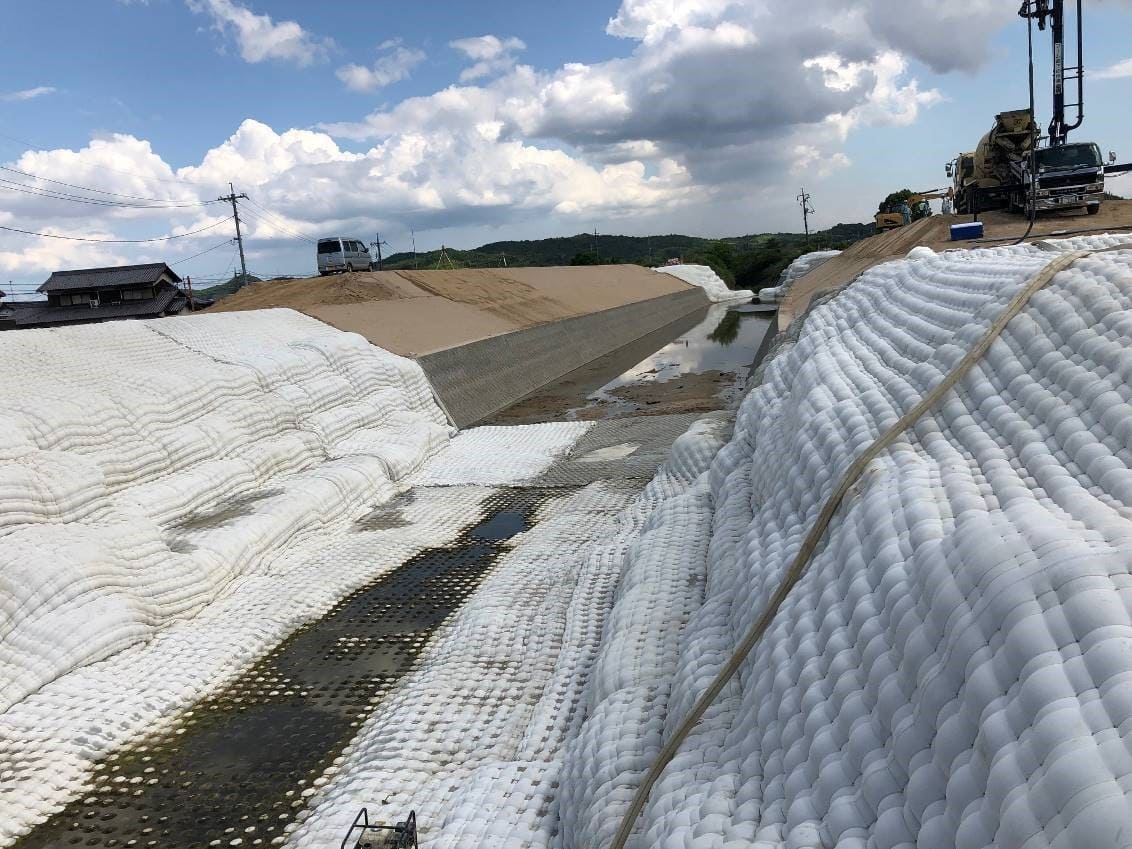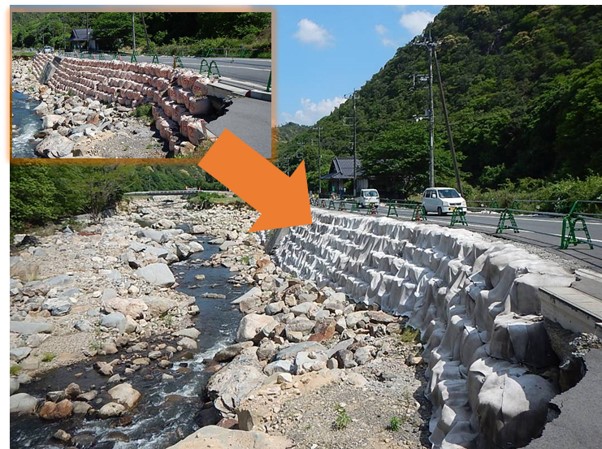

Taiyo Kogyo Column
Six examples of “fabric formwork” for completing three-sided waterway construction in a short period of time.

From the rainy season through autumn, the Japanese archipelago is hit by heavy rains, torrential downpours, and typhoons, resulting in large- and small-scale disasters every year. When rivers overflow or riverbanks collapse, in many cases, concrete placement work is required for river disaster restoration. However, despite the need for immediate action, the following problems exist with conventional concrete placement work involving the assembly of formwork, and local civil engineering staff are at a loss.
- Large heavy equipment and other vehicles are required to enter the site, limiting the conditions of the site that can be handled.
- Need to arrange for skilled workers to assemble the formwork, and manpower is scarce.
- Formwork installation takes time and does not allow for quick restoration work.
Cloth Formwork TACOM” solves this problem and realizes three-sided waterway construction that can be done at any location, does not require skilled labor, and has a short construction period. For those who are looking for a quick method of river disaster restoration work, we would like to introduce the appeal of fabric formwork and actual examples of three-sided waterway construction in which fabric formwork TACOM was used. First, please take a look at the following case studies.
Case 1: Restoration of a waterway that collapsed due to heavy rain (Wakayama Prefecture)
In 2014, a waterway collapsed due to heavy rainfall in Tanabe City, Wakayama Prefecture. For flood control, immediate restoration work was required. However, the topography of the site was complex, making it difficult for heavy machinery to enter the area, and the 250 m2 area that needed work made it too time-consuming and labor-intensive to assemble the formwork. It was determined that the conventional concrete pouring method would not be sufficient, and a different solution was considered. The cloth formwork “Tacom” was adopted. Why was “TACOM” able to realize the construction of a three-sided waterway in a short period of time at a difficult site?
| 施工場所 | 和歌山県田辺市 |
|---|---|
| Part No. | Standard (non-filter) type 150H |
| Scale of restoration | 250m2 |
What is fabric formwork "Tacom": its features and advantages
Fabric formwork “Tacom” is a bag-shaped mat made of synthetic fiber, into which fresh concrete or mortar is poured to form a concrete surface of a certain thickness easily and quickly. Simply by laying the mats, concrete restoration work on riverbanks becomes possible.
The mats are lightweight, compact, and flexible, and can be laid and secured in half to one day, regardless of the site conditions or location. The construction procedure for fabric formwork mainly consists of the following three steps.
- Construction Step 1: Laying and Fixing
- Construction Step 2: Injection Work
- Construction Step 3: Cleaning Work
Construction Step 1: Laying and Fixing
The mat is laid, and a single pipe is passed through the upper side of the slope and secured with chain blocks for support, taking shrinkage into consideration.
Construction Step 2: Injection Work
Insert the injection hose into the inlet of the mat for injection.
Construction Step 3: Cleaning Work
Spilled concrete, dirt, etc. is washed away with water.
Cloth formwork “Tacom” is capable of forming concrete surfaces easily and quickly, yet boasts such high quality and performance that it can be used for main restoration work rather than temporary restoration. The following four features are representative of the fabric formwork “Tacom”.
- Flexible and short construction period (daily construction volume: approx. 300-500m2)
- Diversity in any location
- High durability
- Economical (50H (5cm thick), approx. 6000 yen/m2 or thereabouts)
Flexible and short construction period
Concrete (mortar) can be poured simply by laying the mats on site and securing their surroundings. Mat placement can be completed in half a day to one day for a large area of 300 to 500 m2, allowing for installation by a small number of people and in a short period of time. Large heavy machinery is not required, and installation can be done underwater or in the sea.
Diversity in any location
The mats are lightweight, compact, and flexible, and do not require a specific location or site conditions compared to conventional construction methods such as formwork and taut blocks. Since the mats are factory-processed to suit the site, they adapt well to various ground irregularities and can be installed in a wide variety of shapes. The maximum applicable slope is about 1:10.
High durability
Compared to conventional concrete block stretchers, the mat has a large surface area, making it highly durable against waves and water currents.
economy (saving money)
The cost to form 1 m2 of 5 cm thick concrete surface is approximately 6,000 yen. Since there is no need to set up the formwork, arrange for skilled workers to set it up, or arrange for heavy machinery, the project can be completed in a short period of time and at the same time reduce costs. The following is a case study of a river disaster restoration project in a short construction period using “TACOM,” a fabric formwork with these features.
Example of construction such as three-sided channel construction using fabric formwork "Tacom
The following are five examples of TACOM fabric formwork used primarily in the rehabilitation of waterways.
- Case 2: Protection of river buffer and repair of shed (Tochigi Prefecture)
- Case 3: Slope protection at a landfill site of a waste treatment plant (Okayama Prefecture)
- Case 4: Restoration of riverbank revetment after river disaster (Okayama Prefecture)
- Case 5: Restoration of riverbanks damaged by a river disaster facing a city road (Gifu Prefecture)
- Case 6: Construction to prevent scouring of the drainage area of a retaining wall (Gunma Prefecture)
Case 2: Protection of river buffer and repair of shed (Tochigi Prefecture)
| 施工場所 | 栃木県日光市 |
|---|---|
| Part Number | Standard (non-filter) type 50H (5cm thick type) |
| Scale of construction | 360m2 |
| Construction Period | November 2028 |
Case 3: Slope protection at a landfill site of a waste treatment plant (Okayama Prefecture)
| 施工場所 | 岡山県久米郡美咲町 |
|---|---|
| Part Number | Standard (non-filter) type 50H (5 cm thick type) |
| Scale of construction | 543.7m2 |
| Construction Period | December 2028 |
Case 4: Restoration of riverbank revetment after river disaster (Okayama Prefecture)

Related Articles
- TOP>
- Taiyo Kogyo Column>
- Six examples of “fabric formwork” for completing three-sided waterway construction in a short period of time.








